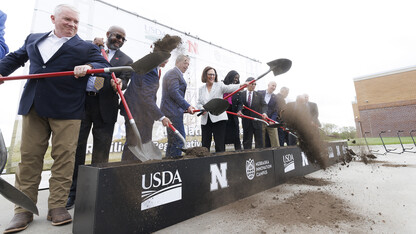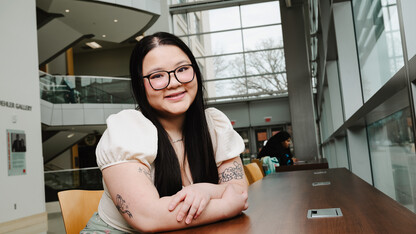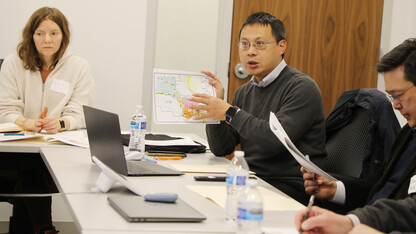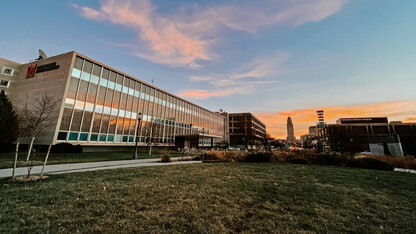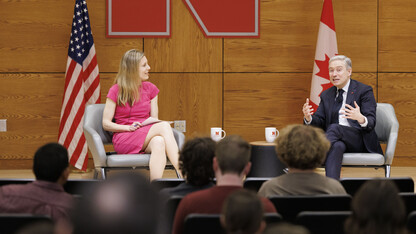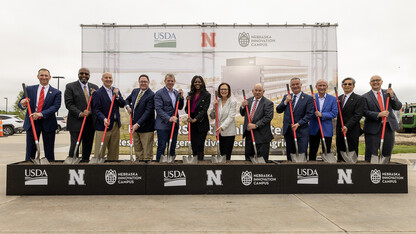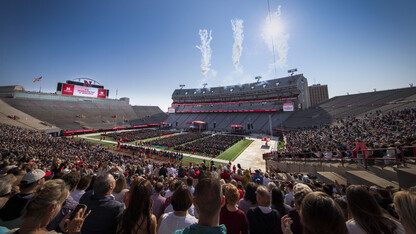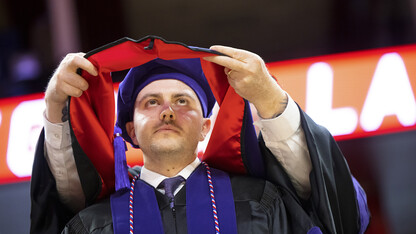· 7 min read
Nebraska in the national news: February 2024

It was a good month to be a Farritor.
Shane Farritor, Lederer Professor of Engineering at the University of Nebraska–Lincoln, and his oldest son, Luke, a senior computer science major in the Jeffrey S. Raikes School of Computer Science and Management at Nebraska, gained media attention in February for separate high-tech projects — one looking to the future of remote surgery and the other using artificial intelligence to delve into an ancient mystery. The coverage was among 80-plus national and international news stories featuring Husker faculty, staff, students, centers and programs during the month.
The Miniaturized In vivo Robotic Assistant (spaceMIRA), controlled by surgeons at Virtual Incision’s headquarters in Lincoln, performed a successful simulated procedure aboard the International Space Station on Feb. 10. The robot was invented by Shane Farritor, who is also co-founder and chief technology officer of Virtual Incision. Stories on the test appeared in at least eight Nebraska media outlets, CBC Kids News, CNN, The Independent, NBC News, NPR, Politico, Smithsonian Magazine, Space.com, The Washington Post and more than 600 other outlets. (The MIRA Surgical System also received Food and Drug Administration approval for commercial use later in the month.)
Luke Farritor was named a co-winner of the $700,000 Grand Prize in the Vesuvius Challenge on Feb. 5 for using AI to decipher at least four passages of text, each 140-plus characters long, from digital scans of a seared scroll. Farritor, 22, collaborated with Youssef Nader of Egypt and Julian Schilliger of Switzerland on the contest. Stories on the team’s accomplishment appeared in KOLN/KGIN, the Lincoln Journal Star, Omaha World-Herald, Bloomberg, CNN, The Independent, Live Science, Nature, NBC News, Scientific American, The Telegraph, Time, Vice, The Wall Street Journal, Yahoo! News and 1,500-plus other media outlets.
Also worth noting
The Midwest Roadside Safety Facility on Jan. 31 released the results of two crash tests indicating that a common guardrail system used on many roads cannot handle electric vehicles, which are heavier and have a lower center of gravity. Coverage continued well into February, with stories in at least eight Nebraska media outlets, as well as AccuWeather, Business Insider, NBC News, The Verge and 800-plus other media outlets.
Additional national news coverage in February included:
Paul Weitzel, law, was quoted in a Feb. 1 Bloomberg Law article on a recent court ruling invalidating Elon Musk’s $55 billion pay package at Tesla. Weitzel said the judge in the case went awry in finding that other board members were beholden to Musk by virtue of their interests in his businesses. “Saying that a director owning stock options makes the director beholden to the CEO” would be “a major shift in the law,” he wrote in a post on X (formerly Twitter).
Kelsy Burke, sociology, was interviewed for a Feb. 3 NPR article on the popularity of online masturbation abstinence groups. She said once someone is in these spaces online, it’s a short leap from self-help to more extreme, misogynist messages. “Undergirding arguments about porn addiction is that the sex industry, which is made of mostly, you know, women who are sex workers, that they are the source of temptation and that they are, frankly, ruining men’s lives,” she said.
Jay Storz, biological sciences, discovered in 2019 that the yellow-rumped leaf-eared mouse is the world’s highest-dwelling mammal. The discovery was highlighted in a Feb. 6 Discover roundup of the six highest-dwelling animals on Earth.
Tim Gay, physics, was featured on a Feb. 7 episode of NPR’s “Short Wave” podcast that delved into a longtime mystery of football physics he helped explain: On a deep, well-thrown pass, why does the front tip of a football follow the ball’s trajectory, so that it points upward when launched but downward by the time it reaches a receiver? Gay and colleagues found that the answer lies in the combination of air resistance and the gyroscope effect.
Frank Ordia, architecture, and community and regional planning, was interviewed for a Feb. 7 USA Today article on historic Black churches receiving preservation funding through the National Trust for Historic Preservation’s African American Cultural Heritage Action Fund. The role that these churches played in social and freedom movements and/or in shaping Black communities makes them part of the American narrative, he said. The article was picked up by the Detroit Free Press, MSN and more than a dozen other media outlets.
Peter J. Capuano, English, was interviewed for a Feb. 8 USA Today article on the resurgence in popularity of “Frankenstein” movies, this time with women as the focus. The 19th-century Mary Shelley novel has been interpreted in recent years as “a dire warning about the dangers of scientific hubris” in regard to nanotech, synthetic biology and especially artificial intelligence, he said.
A first-of-its-kind study from Liang Chen, Earth and atmospheric sciences, has projected decreases in both severe wind and extreme snowfall — the two elements that team up to produce blizzards. Stories on the research appeared in KGFW, KNOP, KOLN/KGIN, Rural Radio Network, the Des Moines Register, Newsweek and PreventionWeb.
Frans von der Dunk, space law, was featured in a Feb. 13 article in Italian outlet AGI. He discussed space mining, its legal parameters and the potential for global conflicts related to it.
Jack Beard, law, director of the Space, Cyber and National Security Law Program, was quoted in a Feb. 15 Washington Post article on revelations that Russia may be seeking to deploy a nuclear weapon in space. “As space gets more and more crowded, you would not be eager to cause widespread destruction in orbit,” he said. “The Russians have shown their recklessness with their (2021) antisatellite mission. It was an irresponsible move that hurt everyone, including them. So they’re not beyond doing reckless saber rattling.”
Africa’s rice sector has major opportunities to increase its yield gains through improved agronomic practices while avoiding massive land conversion, a study by international scientists finds. Patricio Grassini, agronomy, coordinated the team. New Food magazine ran a Feb. 16 article on the study.
New research from a large survey study, co-authored by Husker political scientists Kevin Smith, Kyle Hull and Clarisse Warren, demonstrates the willingness of people to bend their morals — even behave unethically — when engaging in the political realm. Results also suggest that hostility toward outgroups is the driving factor for the moral ambiguity exercised when respondents switch from the personal to the political arena. The research was featured in a Feb. 21 Fast Company article.
A 2022 blog post by Jody Green, an urban entomologist with Nebraska Extension, was cited in a Feb. 21 Smithsonian Magazine article on a new study showing that locust swarms could soon expand to new regions in south and west-central Asia because of climate change. “The desert locust crisis is less about the insect and more about conflict and insecurity among people,” she wrote. “It is a story that demonstrates what can happen when countries do not coordinate enough among one another.”
Kurt Geisinger, director of the Buro Center for Testing at Nebraska, was interviewed for a Feb. 24 Fort Worth Star-Telegram article on the introduction of a computer-based grading system for Texas’ STAAR exam. He said the shift to automated grading shouldn’t be a big cause for concern for local school districts. Automated grading of essays is becoming more common across the country, he said, and has mostly been implemented without major problems, though some question how accurately AI can measure writing quality.
Faculty, administration, student and staff appearances in the national media are logged at http://newsroom.unl.edu/inthenews. If you have additions to the list, contact Sean Hagewood at shagewood2@unl.edu or 402-472-8514. If you have suggestions for national news stories, contact Leslie Reed at lreed5@unl.edu or 402-472-2059.
